Презентація на тему «Australia» (варіант 11)
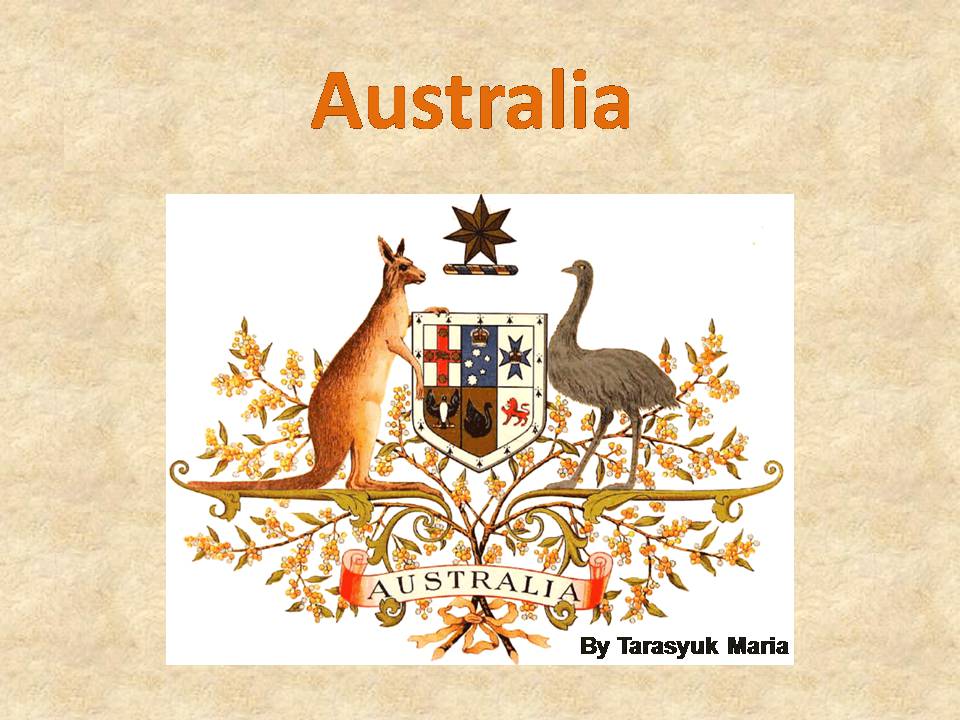
Australia
By Tarasyuk Maria
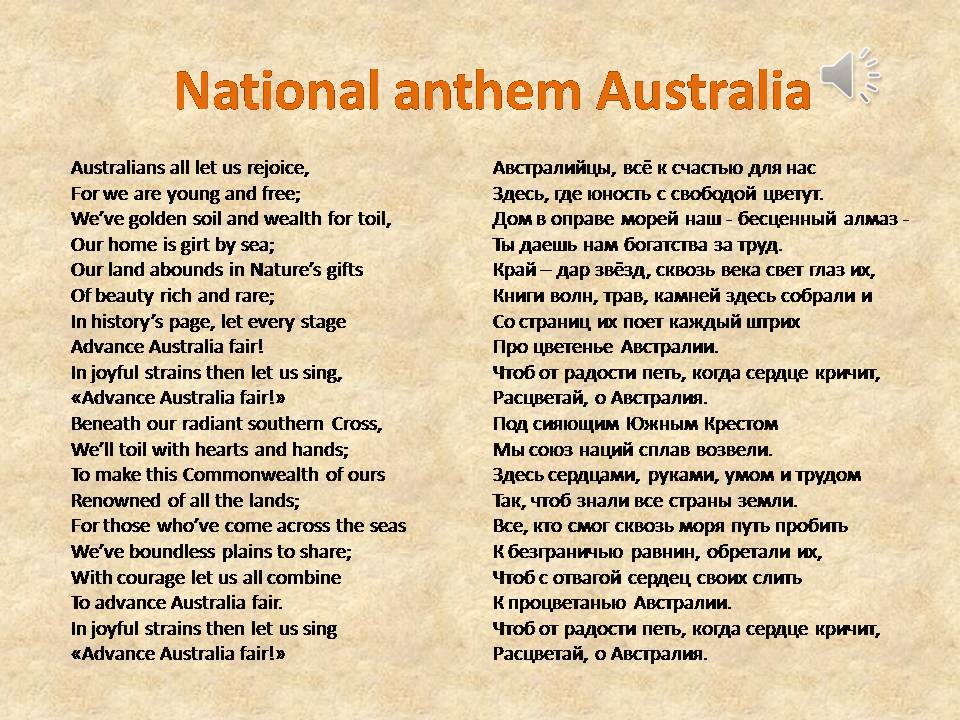
National anthem Australia
Australians all let us rejoice, For we are young and free; We've golden soil and wealth for toil, Our home is girt by sea; Our land abounds in Nature's gifts Of beauty rich and rare; In history's page, let every stage Advance Australia fair! In joyful strains then let us sing, «Advance Australia fair!» Beneath our radiant southern Cross, We'll toil with hearts and hands; To make this Commonwealth of ours Renowned of all the lands; For those who've come across the seas We've boundless plains to share; With courage let us all combine To advance Australia fair. In joyful strains then let us sing «Advance Australia fair!»
Австралийцы, всё к счастью для нас Здесь, где юность с свободой цветут. Дом в оправе морей наш - бесценный алмаз -Ты даешь нам богатства за труд. Край – дар звёзд, сквозь века свет глаз их, Книги волн, трав, камней здесь собрали и Со страниц их поет каждый штрих Про цветенье Австралии. Чтоб от радости петь, когда сердце кричит, Расцветай, о Австралия. Под сияющим Южным Крестом Мы союз наций сплав возвели. Здесь сердцами, руками, умом и трудом Так, чтоб знали все страны земли. Все, кто смог сквозь моря путь пробить К безграничью равнин, обретали их, Чтоб с отвагой сердец своих слить К процветанью Австралии. Чтоб от радости петь, когда сердце кричит, Расцветай, о Австралия.
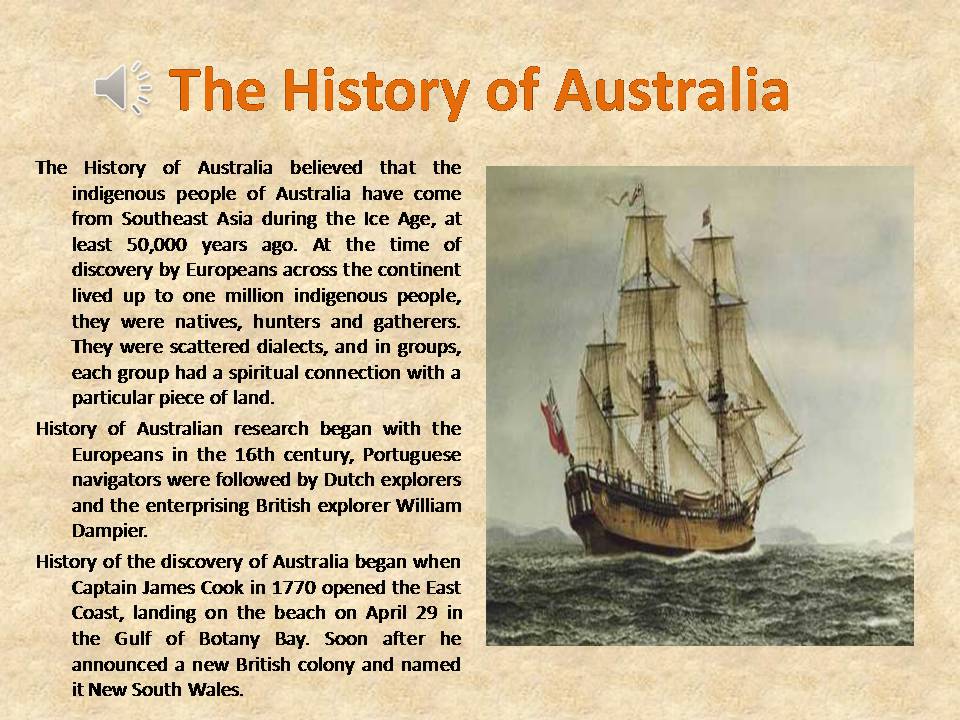
The History of Australia
The History of Australia believed that the indigenous people of Australia have come from Southeast Asia during the Ice Age, at least 50,000 years ago. At the time of discovery by Europeans across the continent lived up to one million indigenous people, they were natives, hunters and gatherers. They were scattered dialects, and in groups, each group had a spiritual connection with a particular piece of land.
History of Australian research began with the Europeans in the 16th century, Portuguese navigators were followed by Dutch explorers and the enterprising British explorer William Dampier.
History of the discovery of Australia began when Captain James Cook in 1770 opened the East Coast, landing on the beach on April 29 in the Gulf of Botany Bay. Soon after he announced a new British colony and named it New South Wales.
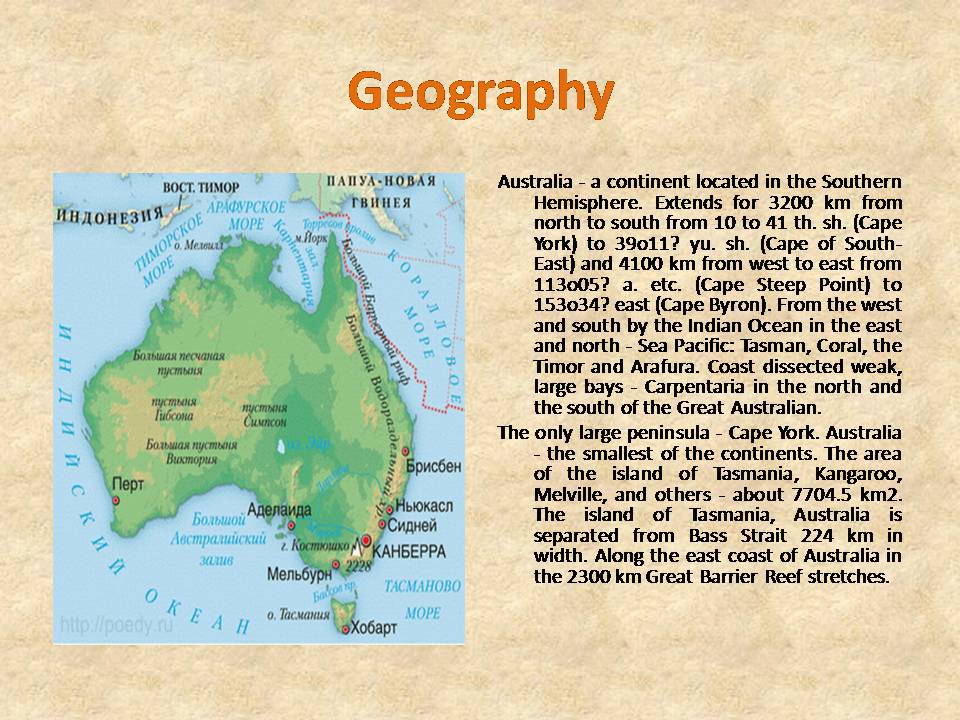
Geography
Australia - a continent located in the Southern Hemisphere. Extends for 3200 km from north to south from 10 to 41 th. sh. (Cape York) to 39o11? yu. sh. (Cape of South-East) and 4100 km from west to east from 113o05? a. etc. (Cape Steep Point) to 153o34? east (Cape Byron). From the west and south by the Indian Ocean in the east and north - Sea Pacific: Tasman, Coral, the Timor and Arafura. Coast dissected weak, large bays - Carpentaria in the north and the south of the Great Australian.
The only large peninsula - Cape York. Australia - the smallest of the continents. The area of the island of Tasmania, Kangaroo, Melville, and others - about 7704.5 km2. The island of Tasmania, Australia is separated from Bass Strait 224 km in width. Along the east coast of Australia in the 2300 km Great Barrier Reef stretches.
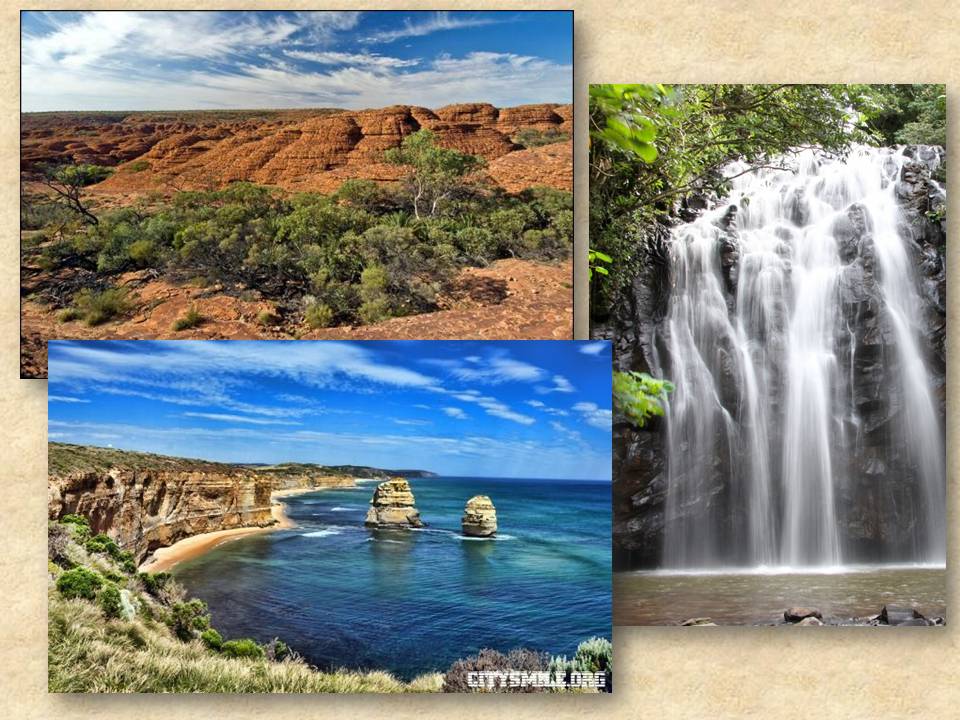
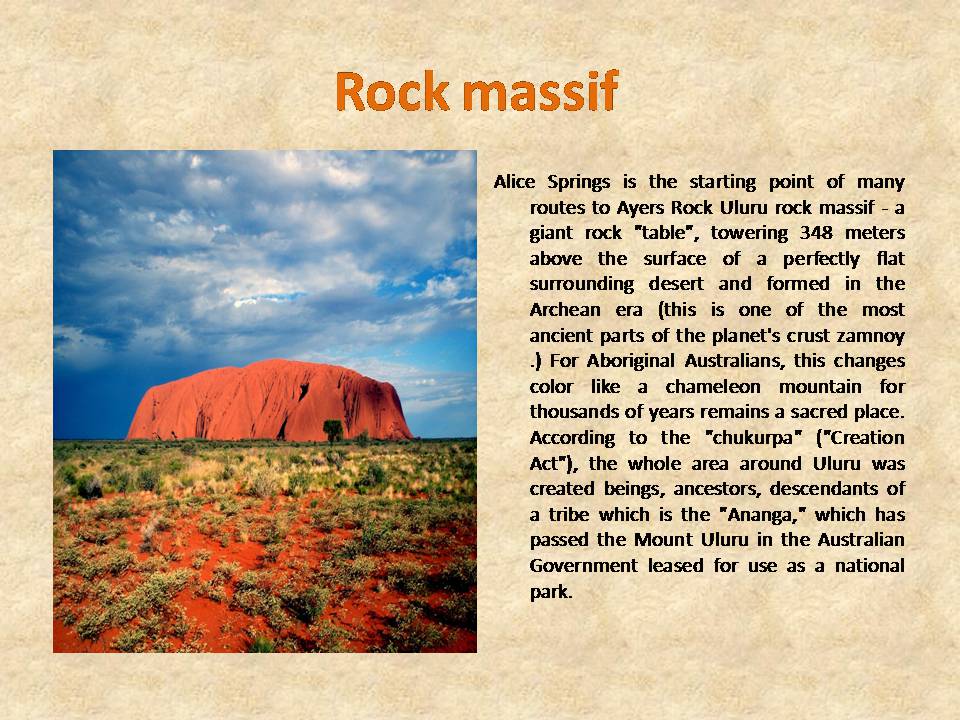
Rock massif
Alice Springs is the starting point of many routes to Ayers Rock Uluru rock massif - a giant rock "table", towering 348 meters above the surface of a perfectly flat surrounding desert and formed in the Archean era (this is one of the most ancient parts of the planet's crust zamnoy .) For Aboriginal Australians, this changes color like a chameleon mountain for thousands of years remains a sacred place. According to the "chukurpa" ("Creation Act"), the whole area around Uluru was created beings, ancestors, descendants of a tribe which is the "Ananga," which has passed the Mount Uluru in the Australian Government leased for use as a national park.
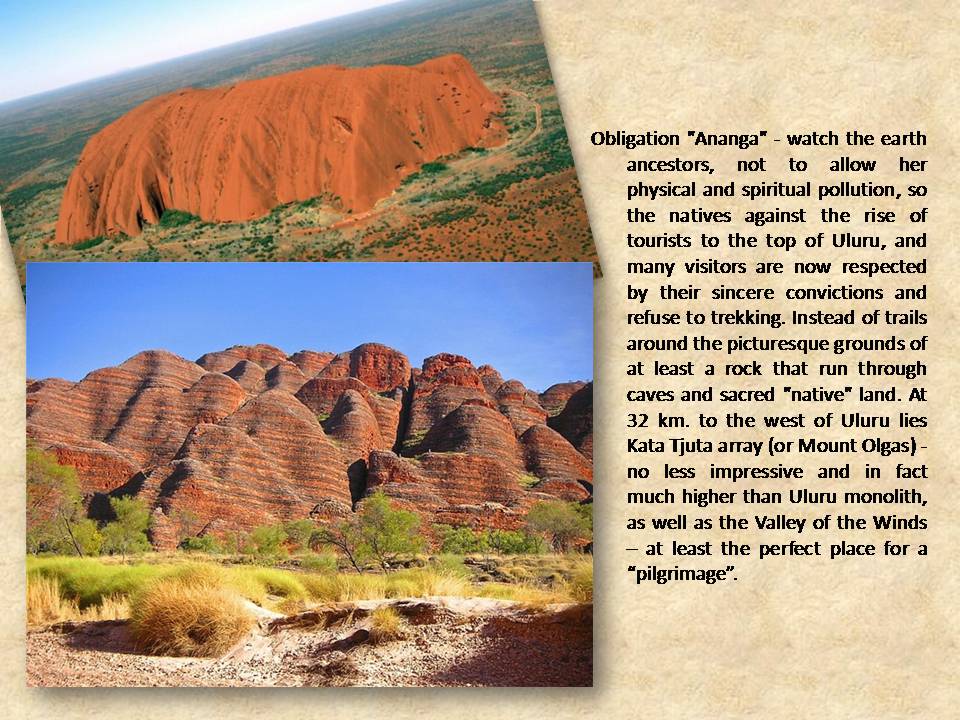
Obligation "Ananga" - watch the earth ancestors, not to allow her physical and spiritual pollution, so the natives against the rise of tourists to the top of Uluru, and many visitors are now respected by their sincere convictions and refuse to trekking. Instead of trails around the picturesque grounds of at least a rock that run through caves and sacred "native" land. At 32 km. to the west of Uluru lies Kata Tjuta array (or Mount Olgas) - no less impressive and in fact much higher than Uluru monolith, as well as the Valley of the Winds – at least the perfect place for a “pilgrimage”.
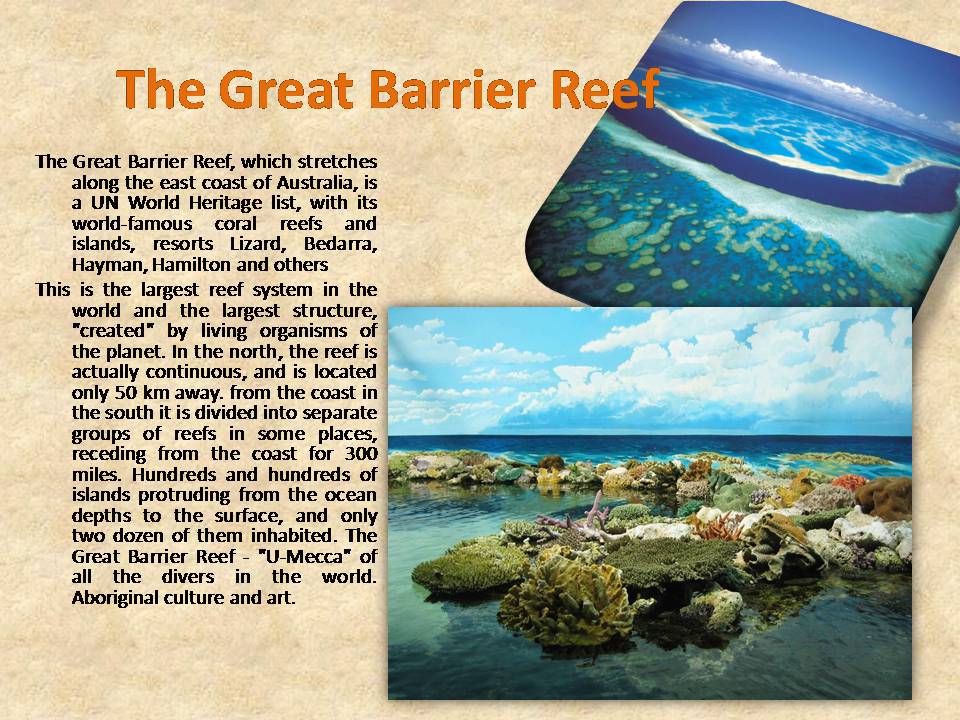
The Great Barrier Reef
The Great Barrier Reef, which stretches along the east coast of Australia, is a UN World Heritage list, with its world-famous coral reefs and islands, resorts Lizard, Bedarra, Hayman, Hamilton and others
This is the largest reef system in the world and the largest structure, "created" by living organisms of the planet. In the north, the reef is actually continuous, and is located only 50 km away. from the coast in the south it is divided into separate groups of reefs in some places, receding from the coast for 300 miles. Hundreds and hundreds of islands protruding from the ocean depths to the surface, and only two dozen of them inhabited. The Great Barrier Reef - "U-Mecca" of all the divers in the world. Aboriginal culture and art.
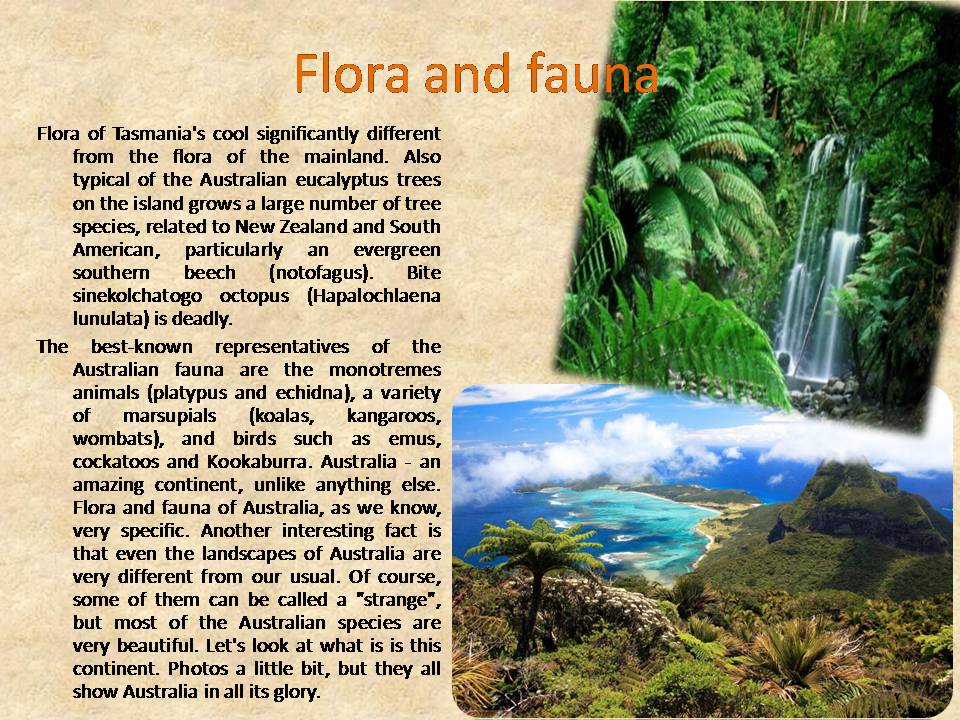
Flora and fauna
Flora of Tasmania's cool significantly different from the flora of the mainland. Also typical of the Australian eucalyptus trees on the island grows a large number of tree species, related to New Zealand and South American, particularly an evergreen southern beech (notofagus). Bite sinekolchatogo octopus (Hapalochlaena lunulata) is deadly.
The best-known representatives of the Australian fauna are the monotremes animals (platypus and echidna), a variety of marsupials (koalas, kangaroos, wombats), and birds such as emus, cockatoos and Kookaburra. Australia - an amazing continent, unlike anything else. Flora and fauna of Australia, as we know, very specific. Another interesting fact is that even the landscapes of Australia are very different from our usual. Of course, some of them can be called a "strange", but most of the Australian species are very beautiful. Let's look at what is is this continent. Photos a little bit, but they all show Australia in all its glory.
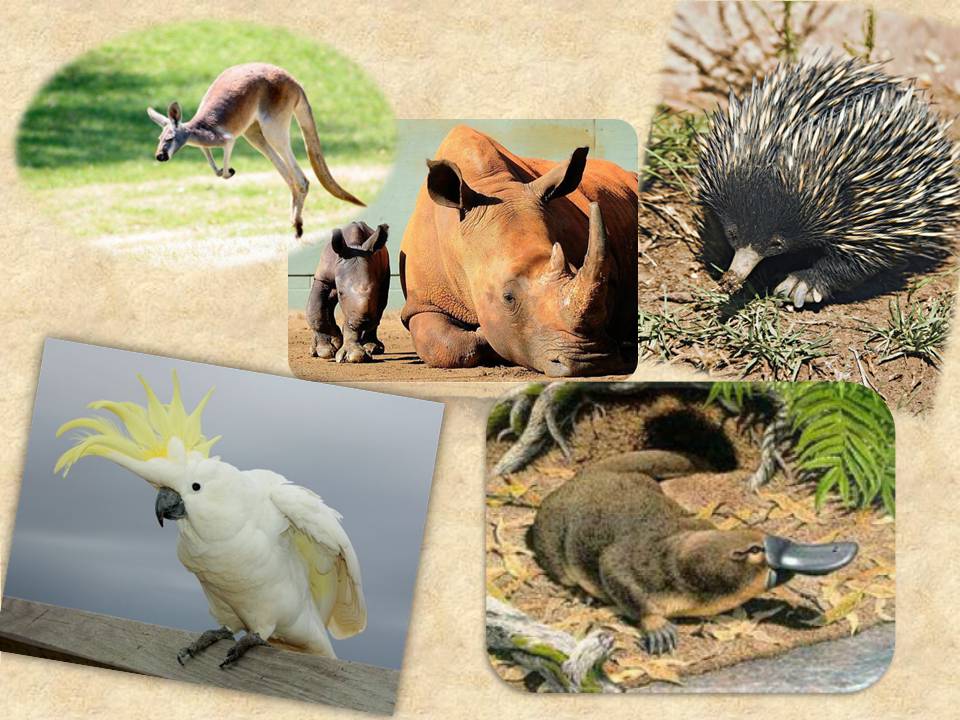
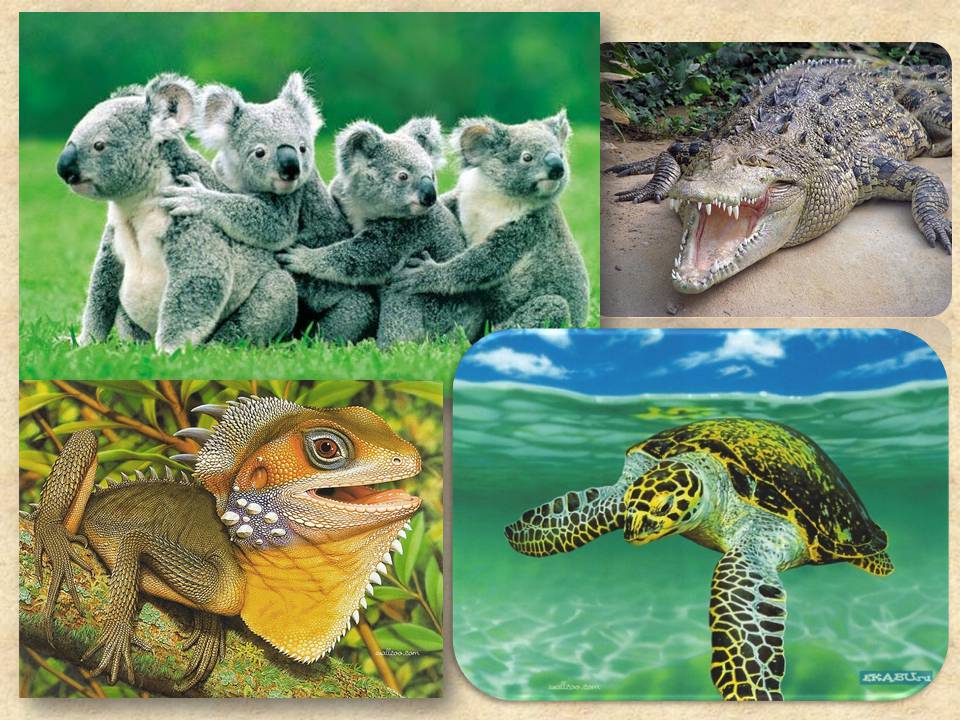
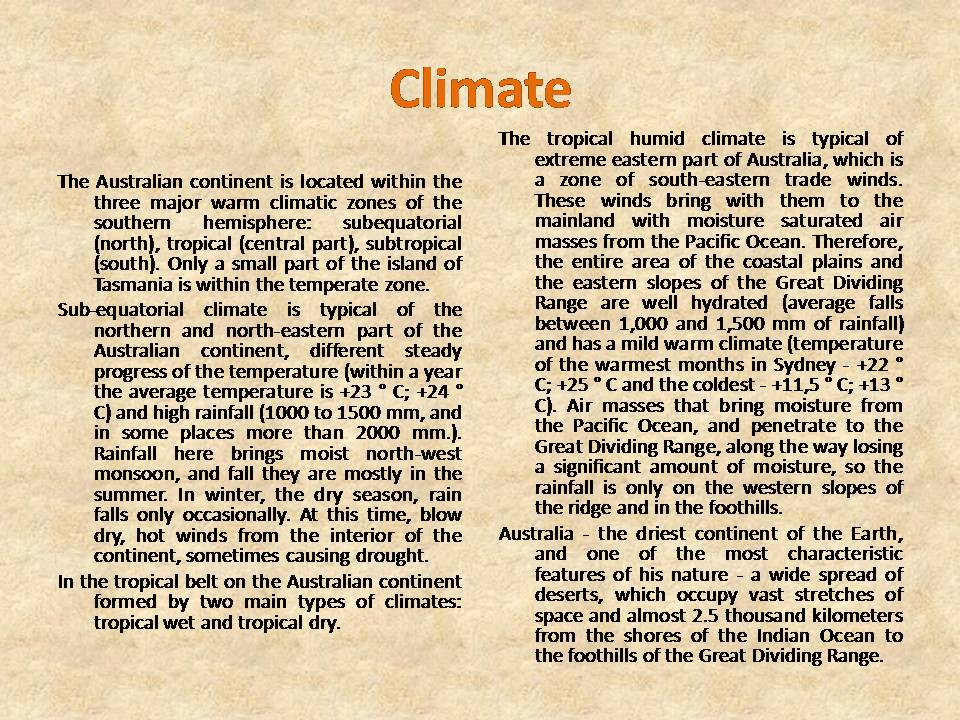
Climate
The Australian continent is located within the three major warm climatic zones of the southern hemisphere: subequatorial (north), tropical (central part), subtropical (south). Only a small part of the island of Tasmania is within the temperate zone.
Sub-equatorial climate is typical of the northern and north-eastern part of the Australian continent, different steady progress of the temperature (within a year the average temperature is +23 ° C; +24 ° C) and high rainfall (1000 to 1500 mm, and in some places more than 2000 mm.). Rainfall here brings moist north-west monsoon, and fall they are mostly in the summer. In winter, the dry season, rain falls only occasionally. At this time, blow dry, hot winds from the interior of the continent, sometimes causing drought.
In the tropical belt on the Australian continent formed by two main types of climates: tropical wet and tropical dry.
The tropical humid climate is typical of extreme eastern part of Australia, which is a zone of south-eastern trade winds. These winds bring with them to the mainland with moisture saturated air masses from the Pacific Ocean. Therefore, the entire area of the coastal plains and the eastern slopes of the Great Dividing Range are well hydrated (average falls between 1,000 and 1,500 mm of rainfall) and has a mild warm climate (temperature of the warmest months in Sydney - +22 ° C; +25 ° C and the coldest - +11,5 ° C; +13 ° C). Air masses that bring moisture from the Pacific Ocean, and penetrate to the Great Dividing Range, along the way losing a significant amount of moisture, so the rainfall is only on the western slopes of the ridge and in the foothills.
Australia - the driest continent of the Earth, and one of the most characteristic features of his nature - a wide spread of deserts, which occupy vast stretches of space and almost 2.5 thousand kilometers from the shores of the Indian Ocean to the foothills of the Great Dividing Range.
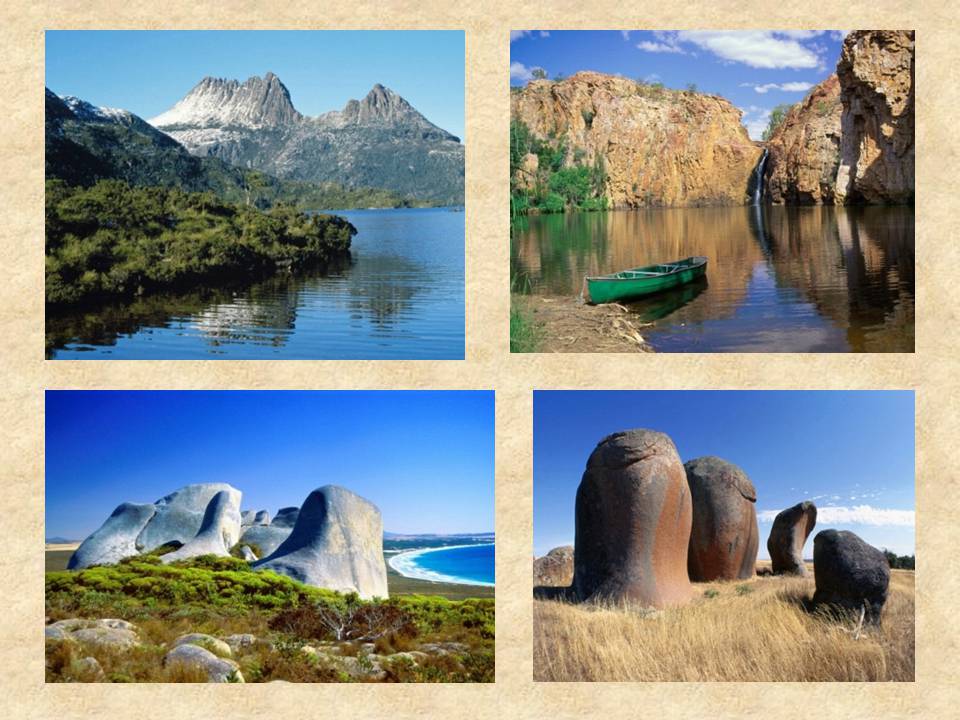
Climate
The Australian continent is located within the three major warm climatic zones of the southern hemisphere: subequatorial (north), tropical (central part), subtropical (south). Only a small part of the island of Tasmania is within the temperate zone.
Sub-equatorial climate is typical of the northern and north-eastern part of the Australian continent, different steady progress of the temperature (within a year the average temperature is +23 ° C; +24 ° C) and high rainfall (1000 to 1500 mm, and in some places more than 2000 mm.). Rainfall here brings moist north-west monsoon, and fall they are mostly in the summer. In winter, the dry season, rain falls only occasionally. At this time, blow dry, hot winds from the interior of the continent, sometimes causing drought.
In the tropical belt on the Australian continent formed by two main types of climates: tropical wet and tropical dry.
The tropical humid climate is typical of extreme eastern part of Australia, which is a zone of south-eastern trade winds. These winds bring with them to the mainland with moisture saturated air masses from the Pacific Ocean. Therefore, the entire area of the coastal plains and the eastern slopes of the Great Dividing Range are well hydrated (average falls between 1,000 and 1,500 mm of rainfall) and has a mild warm climate (temperature of the warmest months in Sydney - +22 ° C; +25 ° C and the coldest - +11,5 ° C; +13 ° C). Air masses that bring moisture from the Pacific Ocean, and penetrate to the Great Dividing Range, along the way losing a significant amount of moisture, so the rainfall is only on the western slopes of the ridge and in the foothills.
Australia - the driest continent of the Earth, and one of the most characteristic features of his nature - a wide spread of deserts, which occupy vast stretches of space and almost 2.5 thousand kilometers from the shores of the Indian Ocean to the foothills of the Great Dividing Range.
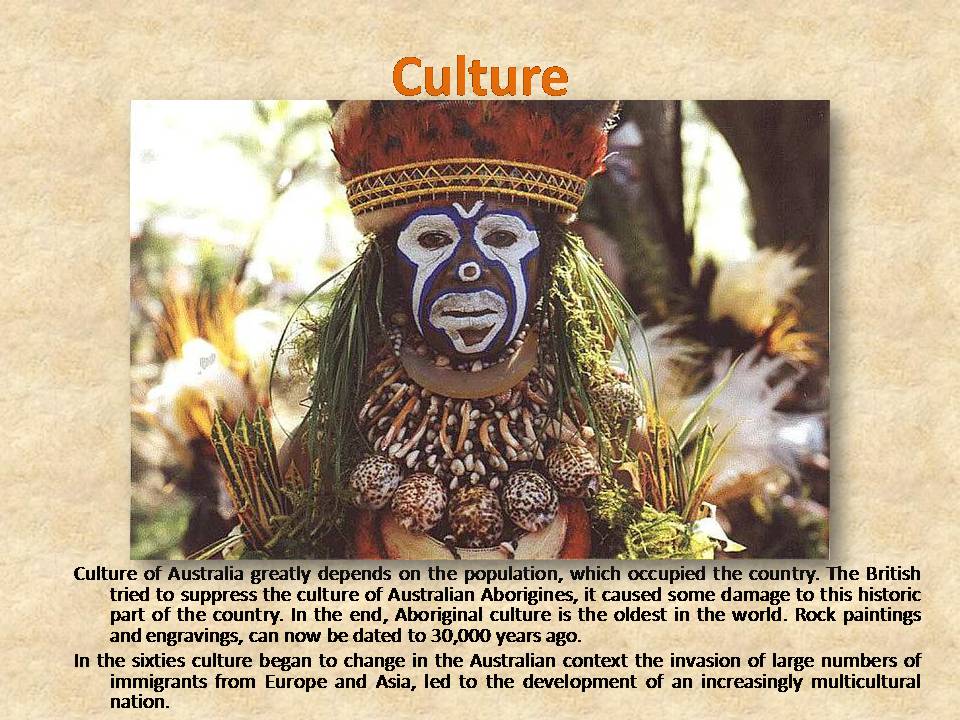
Culture
Culture of Australia greatly depends on the population, which occupied the country. The British tried to suppress the culture of Australian Aborigines, it caused some damage to this historic part of the country. In the end, Aboriginal culture is the oldest in the world. Rock paintings and engravings, can now be dated to 30,000 years ago.
In the sixties culture began to change in the Australian context the invasion of large numbers of immigrants from Europe and Asia, led to the development of an increasingly multicultural nation.
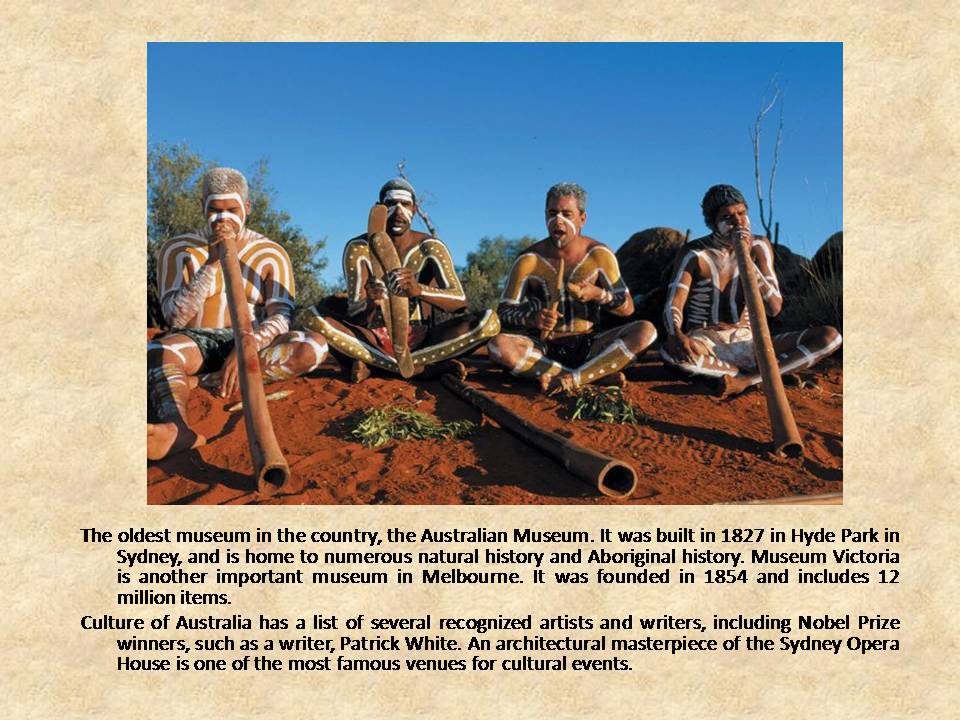
The oldest museum in the country, the Australian Museum. It was built in 1827 in Hyde Park in Sydney, and is home to numerous natural history and Aboriginal history. Museum Victoria is another important museum in Melbourne. It was founded in 1854 and includes 12 million items.
Culture of Australia has a list of several recognized artists and writers, including Nobel Prize winners, such as a writer, Patrick White. An architectural masterpiece of the Sydney Opera House is one of the most famous venues for cultural events.
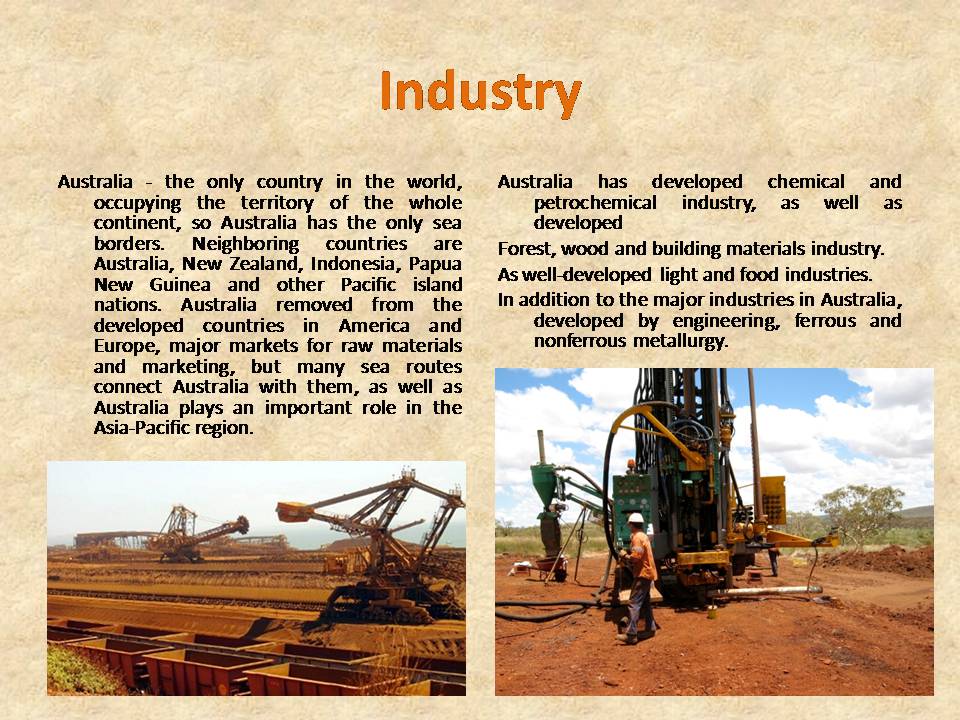
Industry
Australia - the only country in the world, occupying the territory of the whole continent, so Australia has the only sea borders. Neighboring countries are Australia, New Zealand, Indonesia, Papua New Guinea and other Pacific island nations. Australia removed from the developed countries in America and Europe, major markets for raw materials and marketing, but many sea routes connect Australia with them, as well as Australia plays an important role in the Asia-Pacific region.
Australia has developed chemical and petrochemical industry, as well as developed
Forest, wood and building materials industry.
As well-developed light and food industries.
In addition to the major industries in Australia, developed by engineering, ferrous and nonferrous metallurgy.

Thank you for your attention